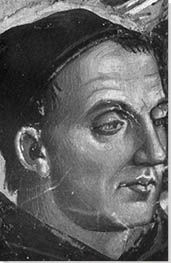Summary of Fra Angelico
Known posthumously as the "Angelic Painter," Fra Angelico helped usher in a revolution in Italian painting. Steeped in the new spirit of Renaissance Humanism, Angelico and young painters such as Masaccio insisted on painting religious subjects in a rational, illusionistic space and with all of the solidity of the human body. A friar in the mendicant Dominican order, Angelico fused piety and artistic innovation to create some of the most deeply moving frescoes and altarpieces of the Early Renaissance period.
His transformation of late medieval painting influenced later Renaissance painters, and his religious devotion and feeling for humanity inspired artists centuries later who were searching for ways out of stale academicism.
Accomplishments
- His time in the monastery meant that Fra Angelico was immersed in an intellectual milieu that married Christian theology with classical texts. This new humanism insisted on the importance of rational thought and ushered in ideas of individual autonomy that shaped the Renaissance.
- Following artists such as Leon Battista Alberti and Masaccio, Fra Angelico translated this emphasis on rationality and precision into painting by creating illusionistic settings using linear perspective to organize his compositions.
- Fra Angelico's artistic career coincided with the changing landscape of patronage in 15th-century Europe. Being a Dominican friar in addition to being a painter meant that many of his early works were commissioned by the increasingly powerful Dominican order, but as his reputation grew, he also received many commissions from the new wealthy class of merchants and bankers in central Italy, cementing his reputation as one of the most important painters of the time.
Important Art by Fra Angelico
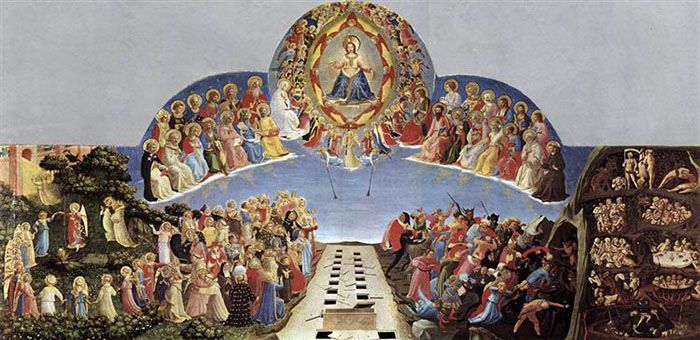
The Last Judgement
Distinctive in its shape, The Last Judgement fulfilled a unique purpose as a seat backing for the priests and attendants during high mass in the church of Santa Maria degli Angeli in Florence. Depicting the narrative in which Christ decides whether the deceased should go to heaven or hell, it is a visually complex composition that shows Fra Angelico adapting traditional Last Judgment prototypes with new innovations. Christ sits elevated in the heavenly skies encircled by a mandorla and a host of angels; to his left and right are the Virgin Mary and St. John the Baptist who are flanked by rows of Saints. Below the heavenly scene, is a long row of opened tombs, signifying the dead to be judged. To the left of the tombs, one sees abundant vegetation, and angels blissfully dancing around the gateway to heaven and gazing towards the skies. Conversely, on the right the damned are forcibly dragged by devils to the depths of hell to incur various punishments.
It is possible that Fra Angelico took over this commission after his teacher Lorenzo Monaco died. The raised halo around Christ's head is a detail more common to older depictions, and the scenes of hellish punishment are copied from another Last Judgment fresco found in Pisa, suggesting that perhaps Fra Angelico did not design the entirety of the composition. What was uniquely his, though, was his innovative use of illusionistic perspective to create a captivating narrative. Likely influenced by the works of Lorenzo Ghiberti that also employed linear perspective, Fra Angelico depicts the tombs receding towards the horizon, creating depth on the flat surface of the panel, and he arranged the Saints in a concave semicircle above, giving the impression that they are seated at different distances to the viewer.
Also unprecedented is the depiction of dancing angels before the gates of heaven. Art historian Chreigton Gilbert suggests that this detail might come from part of a 15th-century hymn based on newly discovered patristic texts that describe how "a wheel is formed in heaven of all the saints in the garden...they all dance for love...they are dressed in particolors, white and red"
Tempera and gold on panel - Museo del Convento di San Marco, Florence

The Deposition of Christ
The wealthy Florentine banker Palla Strozzi commissioned Lorenzo Monaco to create an altar for his family's funerary chapel, and it was installed in 1432. Scholars agree that the pinnacles above the Gothic arches of The Deposition of Christ were completed by Monaco and that the central panel is undoubtedly the hand of Fra Angelico, but there is considerable debate as to whether the altarpiece was left unfinished at Monaco's death or if Angelico was commissioned later to rework the central panel painted by his teacher. In either instance, Angelico created an innovative scene of serenity and drama within the confines of an old-fashioned Gothic frame.
Positioned centrally, Christ's body is lowered from the cross that fills the space below the middle arch, and as is traditional in these scenes, Christ is surrounded by mourners, including Mary Magdalene, who kisses Christ's feet, and the Virgin Mary, who kneels in prayer. To the right of Christ stand John the Evangelist, Nicodemus, and Joseph of Arimathea, but there is also a contingent of men dressed in contemporary Florentine dress, one of whom holds nails and a crown of thorns, relics of Christ's crucifixion. In the foreground, opposite of Mary Magdalene, a friar (perhaps a portrait of Alessio delgi Strozzi, Pallo's recently deceased son) kneels before the scene and gestures towards the viewer, inviting the viewer to mourn Christ's sacrifice.
Despite the restrictive Gothic-style frame, Angelico paints a panoramic view that recedes far into the distance. To the left, we see the towers and buildings of Jerusalem, and to the right the rolling hills and trees of the Tuscan landscape. The juxtaposition of the historical and the contemporary were designed to draw the viewer in and elicit prayerful devotion. Additionally, Fra Angelico's meticulous attention to detail - the blood running down the cross, the grain of the wood, Christ's greenish pallor, and the foliage on the trees - allow the viewer to feel closer to the events unfolding. His use of bright reds and blues enliven the composition, but the respectful, undramatic reactions of the mourners underscore the gravity of the scene. Originally placed across from Gentile da Fabriano's International Gothic Adoration of the Magi, Angelico's Deposition of Christ pointed a new way forward for Italian Renaissance painting.
Tempera and gold on panel - Museo del Convento di San Marco, Florence
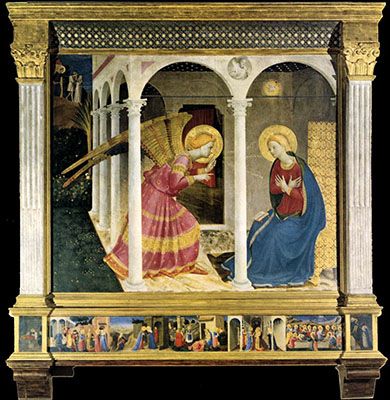
The Annunciation
Executed for the cloth merchant Giovanni di Cola di Cecco for the church of San Domenico in Cortona, The Annunciation conveys the moment in which the archangel Gabriel announced to Mary that she would become the mother to the Son of God. Set in a simple columned loggia with a minimal landscape to the left, Fra Angelico creates a dramatic scene. While the words of Gabriel's announcement (translated as "The Holy Spirt shall come upon thee, and the power of the Highest shall overshadow thee") and Mary's response ("Behold the handmaid of the Lord. Be it unto me according to thy word") are written on the surface of the painting, Fra Angelico followed his contemporary Massacio's lead in creating weighty, solid figures situated in a rationally designed space. The two figures bow inward toward each other, each responding to the other, as they embark on a journey that will be the salvation of humankind. To underscore this theological connection, in the far distance, Angelico depicted the expulsion from Eden of Adam and Eve, whose sin made Christ's salvation necessary. The loggia and garden are symbolic of Mary's chastity and seclusion, and the predella below represents various events in Mary's life.
While the component parts of the scene are minimal, Angelico's training as a manuscript illuminator is evident in this work. The intricate details of Gabriel's robe and the delicate flowers in the grass belie the simplicity of the work. Angelico excelled at presenting different textures; the marble floor of the loggia appears smooth against the ruffles of Gabriel's robe, and the feathered texture of his wings contrast greatly against the polished finish of their haloes. The Cortona Annunciation's masterful display of fine details and illusionistic space set the stage for Angelico's more mature work in the decades that follow.
Tempera and gold on panel - Museo Diocesano, Cortona
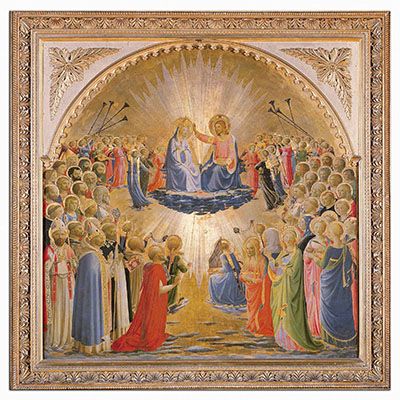
Coronation of the Virgin
A subject depicted many times by Fra Angelico, the Coronation of the Virgin illustrates the crowning of the Virgin Mary as the Queen of Heaven. Possibly commissioned by a group of nuns for the church of Sant'Egidio, the painting depicts an event that takes place on heavenly clouds, where Christ crowns Mary with a diadem. Surrounding the scene are groups of figures, many of whom gaze towards the skies, basking in the heavenly rays; at the front of the crowd, angels swing incense, and in the upper portion of the golden sky, angels plays instruments. In the bottom left corner stands bishop Sant'Egidio dressed in blue, and beside him an archbishop, presumed to be Zenobius, gestures outwards toward the viewer; Saint Dominic, dressed in white with a black robe and holding lillies, directs his glance towards the viewer. To the right are Mary Magdalene and Saints Margaret, Agnes, Lucy, and Cecilia.
Perhaps a request from the nuns who commissioned the painting, the gold background recalls earlier medieval altarpieces that employed gold leaf to suggest a divine space. Fra Angelico's use of it here hindered his usual deep, panoramic backgrounds, but he was still able to create the illusion of some space. Rays of light, incised in the gold leaf emanate from the center point between Mary and Christ, draw out a curve, creating the sought after depth. Additionally, the cloud on which the two sit curves in a concentric shape, also creating the illusion of distance. While still containing a plethora of details, from wisps of clouds to spectacularly illuminated robe hems, there is more of a classicizing symmetry present here than in earlier works.
Tempera on panel - The Uffizi Gallery, Florence
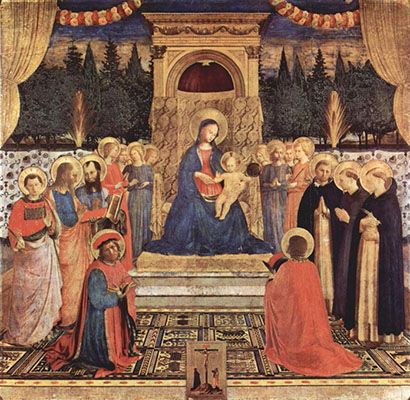
San Marco Altarpiece
Commissioned by Cosimo de' Medici for the San Marco convent, this work is exemplary of Angelico's innovative techniques. The Virgin and Child sit enthroned in the center of the composition. The Christ child makes a blessing gesture with his right hand and holds an orb in his left, signalling his dominion over the world. A patterned curtain behind the throne bisects the composition, and an intricately patterned carpet lays in the foreground. The Virgin and Child are surrounded by a symmetrical retinue of angels and saints; Saints Dominic, Francis, and Peter Martyr stand to the right of them, and to the left are Saints Mark, John the Evangelist, and Lawrence. Saints Cosmas and Damian, patron saints of the Medici Family, kneel before the throne.
Widely regarded as one of the first forms of a sacra conversazione (holy conversation), Angelico's compositional approach was revolutionary for the time. Instead of portraying each of the saints separately in multiple flanking panels, he created a unified space on one panel for all of the figures. Additionally, his precise construction of space, following Alberti's theories, ensure the centrality of the Virgin and Child amidst the numerous figures. The intricate foreshortened rug draws the eye towards the throne, a small set of steps elevates the Virgin and Child, preventing them from becoming lost amongst the Saints, and the naturalistic background creates depth, rendering the enthroned the central focus of the composition. Most representative of Angelico's experimental approach is his inclusion of St. Cosmas; gesturing towards the Virgin and Child and gazing outwards, he calls upon the viewer to direct their attention to the central pair, resulting in an engaging viewing experience that can only be described as revolutionary. The San Marco Altarpiece would become the model for other Florentine altarpieces into the early 1500s.
Tempera and gold on panel - Museo del Convento di San Marco, Florence
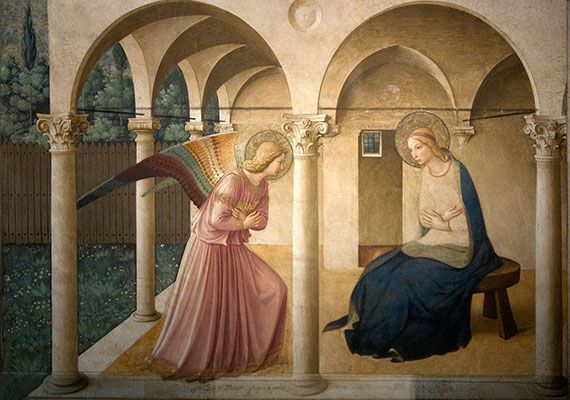
The Annunciation
Fra Angelico and his assistants created over fifty works for the convent at San Marco. The majority were frescoes, and this Annunciation painted in the north corridor is perhaps one of his most famous. Here, Angelico simplified the scene even further than his previous versions; there is no background scene of Adam and Eve expelled from Paradise, the setting is more austere, and the figures more modestly dressed. We can focus completely on Gabriel and Mary at the moment the angel announces that she will miraculously give birth to the Son of God. The loggia remains the setting, but the garden is now fenced. We can see into a sparse room behind Mary that has a small window. These new details further symbolize her chastity and seclusion.
Despite the simplicity of the composition, the fresco exhibits a surprising level of realism. The drapes and folds in Gabriel's and Mary's garments elicit a sense of fluidity, and the plants and trees flourish beyond the columns. Importantly, its placement in the corridor at the top of a staircase would have added to its realism. The indistinct light source in the painting would have appeared to be coming from a nearby window in the stairwell, thus integrating this vision in the monks' physical space as they climbed the stairs to their dormitories. Appearing oversized for the space, Gabriel and Mary are positioned diagonally to one another, creating depth and further drawing the viewer into their interaction. While The Annunciation does not possess the same ornate details as many of Angelico's previous works, it is no less striking in its emotive value.
Fresco - Museo del Convento di San Marco, Florence
Biography of Fra Angelico
Childhood
Baptised Guido di Pietro, little is known of the friar-painter Fra Angelico's childhood. Giorgio Vasari, writer of Lives of the Artists (1550), proposed 1387 as Angelico's date of birth, but many art historians, citing his stylistic correlation with contemporary Italian painter Masaccio, think it more likely that he was born around 1395. While his birth date remains unknown, we do know he was born in the Mugello valley near the town of Vicchio, situated near Florence, and that he was one of three children. Angelico's brother, Fra Benedett, also became a friar, his sister's name was Checca. The identity of his parents remains unknown, but it is widely assumed that Angelico was born into a prosperous family to have received the training as an artist that established the foundations for his artistic career.
Early Training and Work
Angelico likely apprenticed with the artist Lorenzo Monaco (c. 1370-1425), a manuscript illuminator who was in considerably high demand in Florence at the time. Art historian Diane Cole Ahl explained the two artists' stylistic similarities, writing that they shared a "distinctive palette, unequalled in subtlety by any other artist of the day, in which colors are brilliant and myriad in hue, highlighted by thinly brushed filaments of white."
On the recommendation of manuscript illuminator Battista di Biagio Sanguigni, Angelico joined the confraternity of San Niccolò di Bari n 1417. A year later a document recording payment for an altarpiece in Santo Stefano al Ponte (now lost) suggests the beginning of his career as a painter. Sometime between 1418 and 1423, Angelico entered the convent of San Domenico in Fiesole as a friar, alongside his brother, Benedetto, who also worked as a painter and illuminator. His contemporaries, including the likes of Filippo Brunelleschi and Masaccio, would have known him by his new religious moniker Fra Giovanni da Fiesole. As a friar in the Dominican Order, Angelico's devotional practices likely included self-flagellation and fasting in addition to the study of Latin, scripture, and theology. Many have gathered that Angelico was a particularly pious individual, with Vasari going so far to claim that the artist would have never painted a crucifix "without tears running down his cheeks." While undoubtedly a romanticized account, it likely bears some truth as we see within Angelico's work and lifestyle his devotion to the Order and its values, but it is also the case that the Dominican order was one of the leaders of intellectual and artistic activity in Florence at the time and was on the verge of exercising great influence.
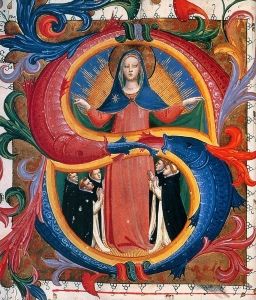
During Angelico's time in San Domenico, he painted an illuminated choir book known as the Messale 558 and three altarpieces for the Dominican convent, including The Virgin and Child with Saints Thomas Aquinas, Barnabus, Dominic and Peter Martyr otherwise known as The San Domenico Altarpiece (c.1422-3). Angelico's works at this time demonstrate his loyalty to Dominican ideals, which revolve around the adoration of Christ and Mary.
By the late 1420s, the artistic sphere in Florence had drastically changed with the passing of several of Angelico's most-noted contemporaries including Masaccio who succumbed to the plague in 1428. Subsequently, Angelico became one of the leading artists in Florence. Garnering the attention of the wealthiest private patrons in the city state, including Cosimo de' Medici and Palla Strozzi, Angelico's popularity increased, and his work extended beyond commissions for the Dominican Order. He was so sought after that he and his brother Benedetto had a fully established workshop by the 1430s, which aided him in completing a vast array of work in a timely manner.
Mature Period
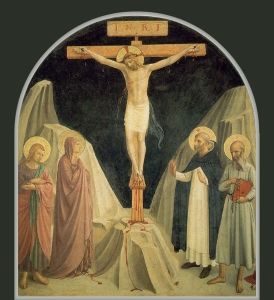
In 1436, Pope Eugenius IV granted ownership of the convent at San Marco to the Dominican Observants, and here Fra Angelico created some of his most famous works. During the renovation of the convent in late 1437-8, Cosimo de' Medici undertook the financing of the complete renovation of the complex and commissioned Angelico to decorate the walls of the convent and to paint perhaps his most known altarpiece for the high altar, known as The San Marco Altarpiece (c. 1438-42). Angelico, along with a retinue of assistants, including Benozzo Gozzoli, took five years to complete the various frescoes and altarpieces that adorn the convent. Inspiring the devotion of the monks, the frescoes at San Marco are considered to be one of the most significant and comprehensive examples of the collaboration between Dominican ideals and art.
Late Period
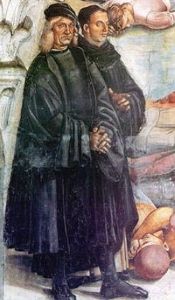
By July 1445, Angelico was summoned to Rome by Pope Eugenius IV, where he stayed until 1450. In 1447, however, Angelico was recorded in Orvieto, working closely alongside his pupil and assistant Benozzo Gozzoli decorating the Chapel of San Brizio in the city's cathedral. The project was left unfinished due to financial issues stemming from the magistrate and was later completed by Luca Signorelli over fifty years later, who included a portrait of Fra Angelico in one his frescoes. Back in Rome, Angelico executed a number of works for Eugenius IV's successor, Pope Nicholas V, many of which were unfortunately destroyed, with the exception of a fresco in his chapel that depicts the lives of Saints Stephen and Lawrence.
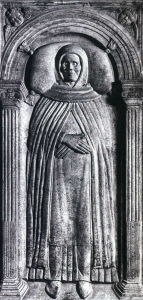
Little is known of Angelico's last years, but he assumed the responsibility as prior of his old convent in Fiesole from about 1449-52. By 1450, Benedetto (Angelico's brother) had passed away. During these years, Angelico likely fulfilled some commissions, including The Silver Chest (c.1451-2), he then returned to Rome one last time, before passing away in the Dominican Convent of Santa Maria sopra Minerva, on February 18, 1455.
Angelico was remembered as somebody who was devoted to his faith and abstained wealth. He was buried in the church of Sant Maria sopra Minerva, where Isaia da Pisa created his effigy; two epitaphs were carved and fixed to the chapel, in which he was referred to as "Angelicus," a description that initiated the name he has been known as since, Fra Angelico, the Angelic Friar.
The Legacy of Fra Angelico
In 1982, Pope John Paul II expressed his admiration for Angelico and beatified him.
While Fra Angelico's piety was legendary, his artistic innovations and his use of color inspired many Renaissance artists, including Luca Signorelli and Raphael, who went so far as to incorporate his portrait into their respective works Sermon and Deeds of the Antichrist (c. 1499-1502) and Disputation of the Holy Sacrament (c. 1509-10) as symbols of devoutness.
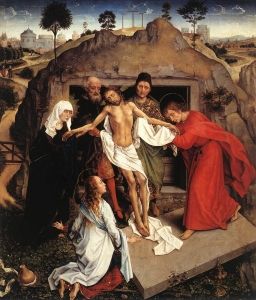
Angelico's reputation moved well beyond Italy, as his compositional inventions were also widely influential for Northern Renaissance artists, including Rogier van der Weyden, who clearly utilised Angelico's compositional structure to create his Lamentation of Christ (c.1460-3).
Much closer to the present, Angelico also influenced the Pre-Raphaelites in England in the middle of the 19th century. Throwing off the high classicism perpetuated by the academy, artists such as Dante Gabriel Rossetti looked to the Early Renaissance not only for techniques but for a more expressive subject. Rossetti's Ecce Ancilla Domini (The Annunciation) (1849-50) exhibits compositional similarities to Angelico's work.
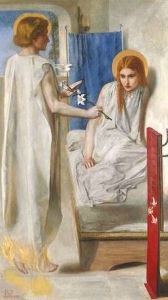
Even today, Fra Angelico's work still serves as an inspiration for many artists. The Pop artists Richard Hamilton cited Angelico as being particularly influential to his work, and this can be seen in his digital collage entitled The Annunciation (2005) which infuses Angelico's color palette and composition into his own personal narrative.
Despite the religious nature of his subject matter, which had largely fallen out of favor in the modern era, Angelico's rendering of narrative built around the innovative construction of space and embodied in brilliant color and painterly grace inspired a range of artists spanning over different eras and cultures.
Influences and Connections

-
![Masaccio]() Masaccio
Masaccio -
![Lorenzo Ghiberti]() Lorenzo Ghiberti
Lorenzo Ghiberti - Lorenzo Monaco
- Gentile di Fabriano
-
![Rogier van der Weyden]() Rogier van der Weyden
Rogier van der Weyden -
![Dante Gabriel Rossetti]() Dante Gabriel Rossetti
Dante Gabriel Rossetti -
![Richard Hamilton]() Richard Hamilton
Richard Hamilton - Benozzo Gozzoli
Useful Resources on Fra Angelico
- Fra AngelicoOur PickBy Diane Cole Ahl / Phaidon Press Limited / 2008
- Fra Angelico: Masters of Italian ArtBy Gabrielle Bartz / Ullmann Publishing / 2013
- Lives of the ArtistsBy Giorgio Vasari / Oxford University Press / 2008
- Fra Angelico to Leonardo Italian Renaissance DrawingsBy Hugo Chapman and Marzia Faietti / British Museum Press / 2010
- Fra AngelicoOur PickBy John Pope-Hennessy / Phaidon Press / 1974
- Fra AngelicoBy Laurence Kanter and Pia Palladino / Yale University Press / 2005
- Fra Angelico: Heaven on EarthBy Nathaniel Silver / Paul Holberton Publishing / 2018
- Fra AngelicoBy Stephan Beissel / Parkstone Press / 2007
- Fra Angelico at San MarcoBy William Hood / Yale University Press / 1993
